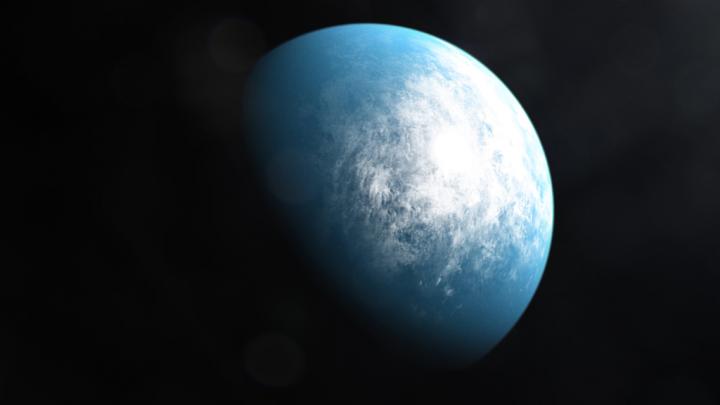TOI 700 d is the first Earth-size habitable-zone world discovered by TESS.
Astronomers have discovered an Earth-sized planet living in its star’s “habitable zone” — a range of distances where conditions allow the presence of liquid water on the planet’s surface. The discovery was made by NASA’s Transiting Exoplanet Survey Satellite (TESS) and was confirmed using NASA’s Spitzer Space Telescope.
The discovery was reported by Emily Gilbert, an astronomer at the University of Chicago in Illinois, at a meeting of the American Astronomical Society in Honolulu, Hawaii, on January 6, 2020. The new planet, called TOI 700 d, orbits a small, cool M dwarf star called TOI 700, which is located just over 100 light-years from Earth in the southern constellation Dorado. TOI 700 d is almost half the size of our own Sun and has about half its surface temperature.
Interestingly, it was originally misclassified in the TESS database as being more similar to our sun, which meant the planets appeared larger and hotter than they really are. Several researchers, including Alton Spencer, a high school student working with members of the TESS team, identified the error.
“When we corrected the star’s parameters, the sizes of its planets dropped, and we realized the outermost one was about the size of Earth and in the habitable zone,” said Gilbert. “Additionally, in 11 months of data we saw no flares from the star, which improves the chances TOI 700 d is habitable and makes it easier to model its atmospheric and surface conditions.”
TESS was launched in 2018 and has since been scanning sectors of the sky to identify changes in stellar brightness caused by an orbiting planet passing in front of its star.
“TESS was designed and launched specifically to find Earth-sized planets orbiting nearby stars,” said Paul Hertz, astrophysics division director at NASA Headquarters in Washington, in a press release published by NASA. “Planets around nearby stars are easiest to follow up with larger telescopes in space and on Earth. Discovering TOI 700 d is a key science finding for TESS. Confirming the planet’s size and habitable zone status with Spitzer is another win for Spitzer as it approaches the end of science operations this January.”
TESS has been able to catch multiple transits of TOI 700’s three planets. “The innermost planet, called TOI 700 b, is almost exactly Earth-size, is probably rocky, and completes an orbit every 10 days,” wrote Jeanette Kazmierczak for NASA.
“The middle planet, TOI 700 c, is 2.6 times larger than Earth — between the sizes of Earth and Neptune — orbits every 16 days and is likely a gas-dominated world. TOI 700 d, the outermost known planet in the system and the only one in the habitable zone, measures 20% larger than Earth, orbits every 37 days, and receives from its star 86% of the energy that the Sun provides to Earth. All of the planets are thought to be tidally locked to their star, which means they rotate once per orbit so that one side is constantly bathed in daylight.”
The data collected by TESS was reconfirmed by the Spitzer Space Telescope in order to ensure the accuracy of the team’s measurements and rule out additional astrophysical causes of the transit signal.
“Given the impact of this discovery — that it is TESS’s first habitable-zone Earth-size planet — we really wanted our understanding of this system to be as concrete as possible,” said Joseph Rodriguez, an astronomer at the Center for Astrophysics at Harvard & Smithsonian in Cambridge, Massachusetts, who led the follow-up observations.
“Spitzer saw TOI 700 d transit exactly when we expected it to. It’s a great addition to the legacy of a mission that helped confirm two of the TRAPPIST-1 planets and identify five more.”
While the exact conditions on TOI 700 d are unknown, scientists can speculate using parameters such as the planet’s size and the type of star it is orbiting. To this end, researchers at NASA’s Goddard Space Flight Center in Greenbelt, Maryland, modeled 20 potential environments of TOI 700, examining a variety of surface types and atmospheric compositions typically associated with potentially habitable worlds.
According to Kazmierczak, “One simulation included an ocean-covered TOI 700 d with a dense, carbon-dioxide-dominated atmosphere similar to what scientists suspect surrounded Mars when it was young. The model atmosphere contains a deep layer of clouds on the star-facing side. Another model depicts TOI 700 d as a cloudless, all-land version of modern Earth, where winds flow away from the night side of the planet and converge on the point directly facing the star.”
The researchers also stated at the conference that TESS has uncovered other intriguing planets, providing new insights into habitable planets that could one day (or already do) support life.

